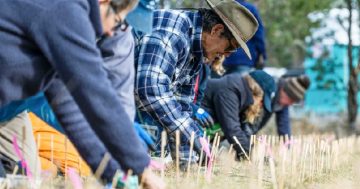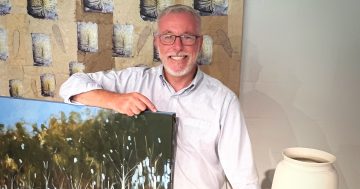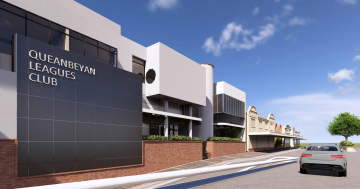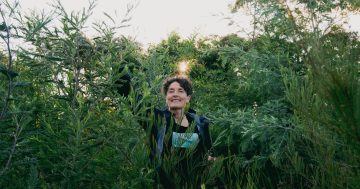
The colour and distinctiveness of the Eurobodalla Regional Botanic Gardens is matched only by the people who got it going and the people who keep it going today.
Those people, the Friends of the Eurobodalla Regional Botanic Gardens are celebrating 30 years of service in 2016.
In keeping with the bottom up way the Gardens have been developed, any celebration the Friends host is part fundraiser for their future redevelopment plans. A recent dinner dance chipped in $6,106.
There is something special about this 42 hectare site just south of Batemans Bay that draws people in.
The former manager of the Gardens John Knight knew that feeling well.
Speaking to him in 2010 for ABC South East, Mr Knight spoke of the perspective the tall timber of the Gardens brought to his life.
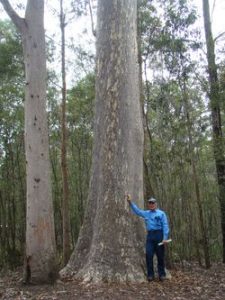
Standing under a 400 year old Spotted Gum Mr Knight said, “If I’ve had one of those days, I just came here and think of the trials of the tree, the things it’s seen in its lifetime, droughts, fires and it still survives.”
Mr Knight told me the gum tree we were standing under wasn’t the oldest or biggest tree in the Gardens.
It’s a history perhaps best understood by the land’s traditional owners, the Walbunga people of the Yuin Nation.
“Puts our current existence into insignificance,” Mr Knight said.
“Ownership” of the land today is tied to the NSW Forestry Corporation, but since 1986 the land has been leased to Eurobodalla Shire Council for the purposes of a botanic gardens.
The original drive came from local resident Pat Speirs, who in the early eighties was witnessing the destruction of local bush land for residential development. The Coastwatchers organisation took on her idea of a flora reserve and led those early discussions between local and state governments.
Richard Roberts from Broulee was a shire councilor at the time the idea of the Gardens was first raised, he went on to serve on the Gardens management committee for 15 years.
Speaking at the Friends’ 30th anniversary ball recently, Mr Roberts hinted at the struggles the idea first faced.
“One of the key things about this garden, is that it is purely native species from this region,” he said.
“When it first came before Council, quite a few of the councilors said, well unless you are going to have Proteas and Geraniums and Hydrangeas it will be a failure.”
Mr Roberts also pointed to frustrations with the Department of Main Roads at the time around access to the Gardens off the busy Princes Highway and a general sense among a few councilors that ratepayer money couldn’t justifiably be spent on such a project.
The Gardens today survive on $510,000 worth of volunteer work each year, supplemented by around $300,000 in funding from Council, plus grants, donations and fundraising.
However the true worth of the Gardens is beyond dollars and cents according to Mr Roberts.
“I get worried with this obsession of making everything pay for itself,” he said.
“To me it’s totally incorrect and doesn’t take into account the public good.”
Current General Manager Michael Anlezark beams as he talks about the 55,000 visitors the Gardens played host to in the last 12 months, a 100% increase on 2011/12 figures.

He sees the public good every day in the form of families picnicking at the play ground, but he also sees it in more measurable ways, describing the Gardens as the Shire’s most significant tourist attraction.
There is conservation and education work also at play in among the grevillias, bandicoots and kingfishers.
Indeed the $800,000 redevelopment plans currently on the drawing board, include an improved herbarium. This scientific collection currently showcases around 7000 dried and pressed plants from the Deua, Clyde and Tuross River catchments, but needs to be better protected.
Meeting space, a bigger visitors centre, retail outlet and more toilets are also part of the so far unfunded plans to further professionalise the Gardens.
The people power behind the Gardens is shaping its future, but the environment in which it sits will always play a significant role.

It’s said that the 1994 bush fires all but destroyed the Gardens, a story that Ken Foster has captured in his pictorial book, “In Among the Gum Trees.”
The photos Mr Foster features show a horizon of scorched earth and blacked trees. The 42 hectare site was totally burned out including the Manager’s cottage and all on-site equipment and sheds.
Debris was removed, seeds collected and infrastructure rebuilt – work started quickly on repairing the devastated site.
The experience was used to strengthen the development of the Gardens with the current Visitors Centre built out of those flames along with new garden displays.

That rebirth process is also captured in Mr Foster’s book, which is currently on sale from local bookstores and the Gardens’ Visitors Centre. All the money raised goes towards the next redevelopment plans.
Based on its history, this partnership between people and plants has a strong future.
Growing numbers of visitors are driving that, but more so the volunteers who give so freely of their time, energy and skill to maintain the Gardens and welcome the people drawn to them.


